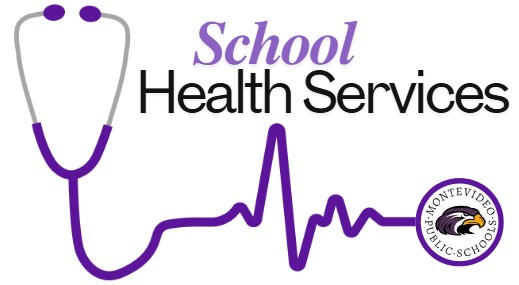Health Services

MEDICAL FORMS
Consent Form for Administration of Medication - English
Consent Form for Administration of Medication - Spanish
Emergency Care Plan Form
MN K-12 Immunization Law/Form - English
MN K-12 Immunization Law/Form - Spanish
Diabetes Medical Management Plan - English
Diabetes Medical Management Plan - Spanish
Seizure Action Plan - English
Seizure Action Plan - Spanish
Asthma Action Plan - English
Asthma Action Plan - Spanish
Food Allergy and Anaphylaxis Care Plan - English
Food Allergy and Anaphylaxis Care Plan- Spanish
Special Diet Statement
RESOURCE LINKS
Heather Goslee, District Nurse
Montevideo High School - 320.269.6446, Ext 1173
Montevideo Middle School - 320.269.6431, Ext 2161
hgoslee@montevideoschools.org
Sarah Jensen
Montevideo Elementary Schools:
Ramsey - 320.269.6584, Ext 4227
Sanford - 320.269.6538, Ext 3266
sjensen@montevideoschools.org
IMMUNIZATIONS
The Minnesota K-12 Immunization Law requires students to receive certain vaccines for school or submit an exemption. This requirement applies for all public, private, online, and home schools in Minnesota.
Required Immunizations include Diphtheria, Pertussis and Tetanus (DTaP/Tdap); Polio (IPV); Measles, Mumps and Rubella (MMR); Hepatitis B (Hep B); Meningococcal ACWY (MenACWY); and Varicella (Chicken Pox). Parents/guardians must complete and file a form if your child requires an exemption for medical reasons or if you are opting for a non-medical exemption due to personal beliefs.
Are Your Kids Ready? View the required immunizations chart, access the Medical and Non-Medical Exemption Form, and learn more by selecting the MN K-12 Immunization Law document:
MN K-12 Immunization Law/Form - English
MN K-12 Immunization Law/Form - Spanish
Immunizations and number of doses vary according to age and grade level. Make sure your child’s immunizations are up-to-date and on file at your child's school. If you have any questions, contact your healthcare provider or Countryside Public Health, 1-800-657-3291.
HEAD LICE PROCEDURE
A student found to have head lice in his/her hair will be sent home from school. Treatment with lice-killing shampoo will have to be completed and ALL eggs removed from the hair before he/she will be readmitted to school. Parents are responsible for checking other children at home and for implementing control measures to prevent reinfestation of head lice.
For more information Head Lice Fact Sheet:
https://www.health.state.mn.us/diseases/headlice/headlice.html
DENTAL HEALTH RESOURCES
Minnesota Dental Association Dental Care Resources
SCHOOLS AND CHILD CARE COVID-19
MN Department of Health: Schools and Child Care COVID-19
Parent and Caregiver Information
The Minnesota Department of Health (MDH) provides recommendations for schools, child care settings, youth programs, and camps to slow the spread of COVID-19. Different settings have varying requirements or processes for deciding which COVID-19 prevention strategies to use. Contact your child's program for more information about their specific requirements, recommendations, or strategies.
When your child is sick or has been exposed:
Your child can spread COVID-19 to others starting a couple days before they have any symptoms, and even if they never have any symptoms. If your child spent time close to someone with COVID-19, they may also have it, but you may not know that they do. It is important to keep them home when they are sick to keep from spreading the virus to others.
Your child can go back to their normal activities when, for at least 24 hours, both are true:
Their symptoms* are getting better overall, and
They have not had a fever (and are not taking fever-reducing medication
While the CDC (Centers for Disease Control and Prevention) no longer recommends quarantine (staying home) after being around someone with (exposure to) COVID-19, it is still recommended that people take precautions, such as wearing masks, physical distancing, and/or testing when around other people indoors, whether or not they are vaccinated or have had a previous infection.
Current CDC recommendations give steps that you can help your child take to avoid spreading respiratory viruses to others: CDC: Preventing Spread of Respiratory Viruses When You’re Sick.
MDH strongly encourages staff of schools, child care, youth programs, and camps to follow steps to protect the health of children in their programs by:
Reporting when a child is sick
Managing the follow-up of sick children
Notifying people who have been around a sick child or staff member
Following these steps as much as possible while also considering educational needs, the social and emotional well-being of children, and the importance of children's access to learning and care
*Symptoms may include but are not limited to chest discomfort, chills, cough, decrease in appetite, diarrhea, fatigue (tiredness), fever or feeling feverish, headache, muscle or body aches, new loss of taste or smell, runny or stuffy nose, sneezing, sore throat, vomiting, weakness, wheezing.
RESPIRATORY ILLNESSES
CDC Respiratory Illnesses
When you may have a respiratory virus...
Stay home and away from others (including people you live with who are not sick) if you have respiratory virus symptoms that aren't better explained by another cause. These symptoms can include fever, chills, fatigue, cough, runny nose, and headache, among others.
You can go back to your normal activities when, for at least 24 hours, both are true:
Your symptoms are getting better overall, and
You have not had a fever (and are not using fever-reducing medication).
When you go back to your normal activities, take added precaution over the next 5 days, such as taking additional steps for cleaner air, hygiene, masks, physical distancing, and/or testing when you will be around other people indoors. This is especially important to protect people with factors that increase their risk of severe illness from respiratory viruses.
Keep in mind that you may still be able to spread the virus that made you sick, even if you are feeling better. You are likely to be less contagious at this time, depending on factors like how long you were sick or how sick you were.
If you develop a fever or you start to feel worse after you have gone back to normal activities, stay home and away from others again until, for at least 24 hours, both are true: your symptoms are improving overall, and you have not had a fever (and are not using fever-reducing medication). Then take added precaution for the next 5 days.
